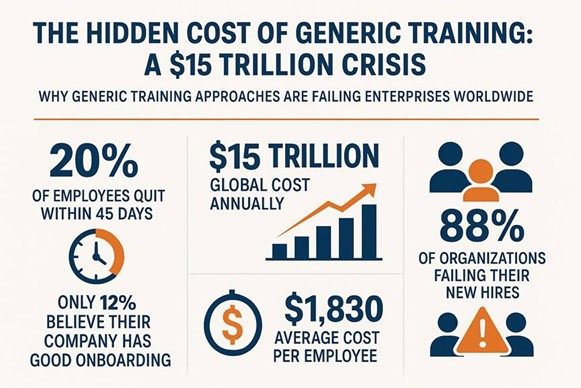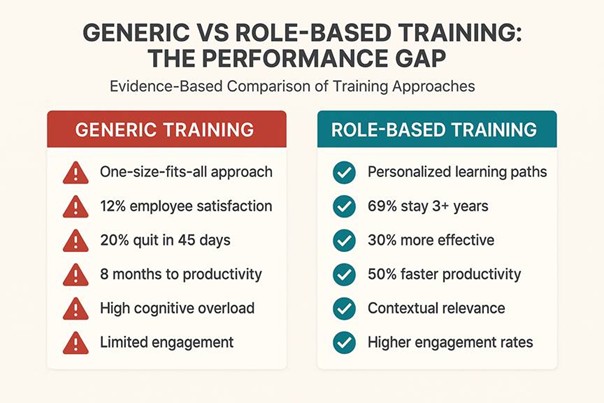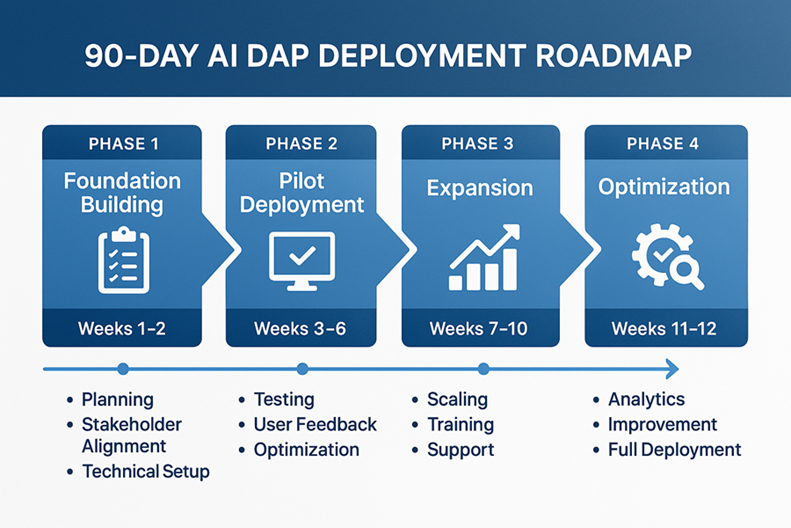Table of Contents
- Executive Summary
- The Shocking Truth: Every 45 Days, Your Best Talent Walks Out the Door
- The Evidence: What the Data Reveals About Training Effectiveness
- The Solution Unveiled: Building Role-Based Training Plans That Work
- Industry-Specific Deep Dive: How Different Sectors Customize Training
- The Apty Advantage: Why Leading Enterprises Choose Business Impact Over Adoption
- Measuring Success: Beyond Completion Rates to Real Business Impact
- Your Next Steps: Transforming Training from Cost Center to Competitive Advantage
- Key Takeaways
- FAQs
- Ready to Transform Your Employee Training?
Executive Summary
Employee training, particularly onboarding, is often underoptimized and carries significant hidden costs for mid-sized enterprises. While most organizations believe they onboard well, employees often disagree. This disconnect contributes to high turnover and ineffective productivity. Traditional onboarding methods, while costly, fail to address the real needs of employees, resulting in long ramp-up times, higher error rates, and escalating support tickets.
The emerging solution lies in role-based training, driven by AI-powered Digital Adoption Platforms (DAPs). These platforms personalize training for new hires, accelerating their time-to-productivity by 50-70% while reducing errors and support issues. With AI-powered onboarding, organizations report 3.4x ROI in the first year. This comprehensive guide explores how AI-powered DAPs are revolutionizing the onboarding process, offering measurable results in weeks instead of months. By transforming onboarding from a cost center to a strategic competitive advantage, mid-sized enterprises can lower turnover costs, boost productivity, and ensure a higher return on training investments.
The Shocking Truth: Every 45 Days, Your Best Talent Walks Out the Door
Did you know that every 45 days, 20% of new hires leave the organization? But here’s what HR leaders don’t want you to know: this exodus isn’t just about salary negotiations or workplace culture. It’s about a fundamental failure in how organizations approach employee onboarding and training.
Additionally, only 12% of employees believe their organization has a good onboarding process, yet companies continue to invest billions in approaches that demonstrably fail to meet expectations. Meanwhile, the global cost of ineffective training has reached a staggering $15 trillion annually, representing one of the largest wastes of corporate resources in modern business history.

But perhaps the most neglected statistic of all? Sixty-eight percent of employees prefer to learn and train on the job. Yet, the vast majority receive generic, classroom-style training that bears no resemblance to their actual job responsibilities. It’s like teaching everyone to perform surgery when some need to be accountants, others need to be engineers, and still others need to be customer service representatives.
Is your current onboarding approach costing your organization more than you think?
Use this Cost of Inaction Calculator to see how much your organization could be losing by sticking with ineffective training methods. It’s an easy way to identify the hidden costs of poor training.
If you are thinking this is just an HR problem, then you are wrong. In fact, it’s a business crisis hiding in plain sight. Every day, organizations hemorrhage talent, productivity, and competitive advantage because they persist with one-size-fits-all training approaches that research has proven ineffective.
The solution exists, it’s measurable, and it’s transforming how leading enterprises approach talent development. Role-based training delivers 30% better results than generic programs, yet most organizations haven’t made the switch.
The Evidence: What the Data Reveals About Training Effectiveness

The evidence against generic training approaches is overwhelming, yet most organizations continue to ignore the data in favor of familiar but ineffective methods. A comprehensive analysis of training effectiveness reveals a pattern of systemic failure that costs enterprises billions while delivering minimal business value.
Companies with comprehensive employee training programs generate 218% higher income per employee than those without formalized training. This is a transformational difference that separates market leaders from laggards. Yet the key word here is “comprehensive,” which increasingly means role-specific rather than generic.
The productivity impact is equally dramatic. Organizations are 17% more productive when employees receive the training they need, but the critical phrase is “the training they need.” Generic training programs fail because they provide information that may be irrelevant to specific roles, creating cognitive overload while missing critical job-specific competencies.
Consider the retention implications. Sixty-nine percent of employees who experience exceptional onboarding are likely to stay with their organization for at least three years, compared to 20% who quit within 45 days when onboarding fails. This represents a 3.45x difference in retention rates, a gap that translates to millions in reduced turnover costs for mid-sized enterprises.
Wondering if your organization is ready for a role-based training transformation?
Take our DAP Strategy Readiness Assessment to see where your team stands and what steps are needed to make a seamless transition. Planning ahead ensures success and maximizes training ROI.
The Solution Unveiled: Building Role-Based Training Plans That Work

The transformation from generic to role-based training requires a systematic approach that addresses the unique competency requirements of different positions while leveraging technology to deliver personalized learning experiences at scale. Leading organizations have developed proven methodologies that consistently deliver superior outcomes compared to traditional training approaches.
Step 1: Comprehensive Role Analysis and Competency Mapping
Effective role-based training begins with a detailed analysis of what each position actually requires for success. This goes beyond job descriptions to examine the specific tasks, decisions, and interactions that define daily work experiences. Training plans for new hires should be grounded in an empirical understanding of role requirements, rather than relying on assumptions about what employees should know.
Step 2: Creating Dynamic Role-Specific Learning Paths
Once competency requirements are mapped, organizations can design customized employee training paths that address specific role needs while accommodating individual learning preferences and prior experience. This personalization goes far beyond simply selecting different content modules—it involves creating adaptive experiences that respond to learner progress and performance.
Step 3: Contextual Content Development and Curation
The content within role-based training programs must reflect the actual work environment and challenges employees will encounter. This means moving beyond generic presentations and videos to create immersive, realistic learning experiences that mirror daily job responsibilities.
Step 4: Technology Integration for Scalable Personalization
The scalability challenge has historically prevented widespread adoption of role-based training, but modern technology solutions make personalization feasible for organizations of all sizes. AI recruitment software and other AI-powered platforms can analyze role requirements, assess individual competency levels, and automatically generate personalized learning experiences that adapt based on performance and feedback.
Step 5: Measurement and Continuous Optimization
Effective job-specific training plan implementation requires robust measurement frameworks that track both learning outcomes and business impact. This goes beyond traditional training metrics to examine how role-based training affects productivity, quality, retention, and customer satisfaction.
Industry-Specific Deep Dive: How Different Sectors Customize Training

The implementation of role-based training varies significantly across industries, reflecting unique regulatory requirements, operational complexities, and competitive dynamics that shape how organizations approach talent development. Understanding these industry-specific patterns reveals both common success factors and sector-specific optimization strategies.
- Financial Services: Compliance-First Role Specialization
The financial services industry presents perhaps the most complex role-based training challenges, combining sophisticated technology systems with stringent regulatory requirements and high-stakes decision-making processes. Financial institutions face an average of 47 different regulatory requirements that must be incorporated into employee training, making generic approaches inadequate for ensuring consistent compliance.
- Healthcare: Safety-Critical Role Differentiation
Healthcare organizations face unique training challenges that combine life-critical accuracy requirements with complex regulatory environments and rapidly evolving technology systems. Medical errors cost the U.S. healthcare system $20 billion annually, making effective training a patient safety imperative rather than just an operational efficiency goal.
- Manufacturing: ERP Mastery and Safety Integration
Manufacturing organizations face complex training challenges that combine sophisticated Enterprise Resource Planning (ERP) systems with critical safety requirements and quality control procedures. Manufacturing ERP systems typically include 200+ different functions, making comprehensive training a significant challenge for traditional approaches.
- Technology: Agile Role-Based Development
Technology companies face unique training challenges related to rapid skill evolution, cross-functional collaboration, and continuous learning requirements. 81% of employers used skills-based hiring in 2024, reflecting the industry’s focus on specific competencies rather than general qualifications.
The Apty Advantage: Why Leading Enterprises Choose Business Impact Over Adoption

In the crowded landscape of training and digital adoption solutions, Apty stands apart through its fundamental focus on business execution rather than software adoption metrics. While competitors measure success through feature usage and click-through rates, Apty delivers measurable improvements in productivity, accuracy, and performance that directly impact organizational results.
- Business Execution Focus vs. Software Adoption Metrics
The distinction between business execution and software adoption represents a fundamental philosophical difference that shapes every aspect of platform design and implementation. Traditional Digital Adoption Platforms focus on increasing software usage, measuring success through metrics such as feature adoption rates, user engagement scores, and session duration.
Apty’s approach recognizes that software usage is merely a means to an end; the real objective is business performance improvement.
The platform measures what actually matters: errors avoided, processes completed, and business performance accelerated. This focus ensures that technology implementation serves business objectives rather than becoming an end in itself.
- Cross-Application Excellence for Complex Role Requirements
Modern business roles rarely involve single applications; they require seamless coordination across multiple software systems to complete complex workflows. Apty optimizes workflows across entire software ecosystems, treating the technology stack as a unified system rather than a collection of separate tools.
This holistic approach delivers 27% improvement in cross-application efficiency, eliminating the context switching and process gaps that plague traditional single-application guidance systems. For role-based training, this means employees can learn complete business processes rather than isolated software functions.
- Practical Implementation: Results in Days, Not Months
Traditional DAP implementations require months of setup, specialized technical skills, and extensive customization before delivering any value. This extended timeline creates organizational resistance and delays ROI realization, making many implementations unsustainable.
Apty delivers measurable results within 14 days, with full implementation typically completed in 2–4 weeks rather than months. This speed advantage stems from Apty’s implementation methodology that focuses on high-impact processes first rather than attempting comprehensive coverage immediately.
Measuring Success: Beyond Completion Rates to Real Business Impact

Your Next Steps: Transforming Training from Cost Center to Competitive Advantage
The evidence is overwhelming, the technology is available, and the competitive advantages are clear. The only remaining question is implementation: how will your organization transition from generic training approaches to role-based systems that deliver measurable business value?
- Organizational Readiness Assessment
Before implementing any role-based training solution, organizations must honestly evaluate their current state and readiness for transformation. This assessment prevents 73% of common implementation problems by identifying and addressing potential obstacles before they become blocking issues.
- Implementation Planning Framework
Phase 1: Foundation Building (Weeks 1-2)
The foundation phase establishes project governance, aligns stakeholders, and sets technical prerequisites. Strong foundations account for 78% of implementation success, making this phase critical for achieving long-term results.
Phase 2: Pilot Deployment (Weeks 3-6)
The pilot phase focuses on a single, high-impact use case that can demonstrate clear value quickly. Successful pilots typically involve 20-50 users in roles where training challenges are well-documented and business impact is easily measurable.
Phase 3: Expansion and Optimization (Weeks 7-12)
Based on pilot success, the expansion phase extends role-based training to additional departments or processes. Expansion success depends on maintaining pilot-phase effectiveness while scaling to larger user populations.
The Apty Implementation Advantage:
Apty’s implementation methodology eliminates common barriers that prevent successful role-based training deployment. The platform’s design philosophy focuses on minimizing complexity while maximizing business impact, making effective training accessible to organizations of all sizes.
Results in 14 days rather than months eliminate the extended implementation timeline that creates organizational resistance. Apty’s methodology focuses on high-impact processes first, delivering measurable improvements quickly while building confidence for broader deployment.
Want to learn more about how to implement role-based training effectively? Book a demo with Apty to understand the complete methodology behind successful role-based training implementation. Learn how to align technology with business outcomes for accelerated ROI.
Key Takeaways
- Role-Based Training: Transitioning from generic to role-based training can improve results by 30%, offering personalized, relevant learning experiences for each employee.
- AI-Powered DAP Benefits: AI-driven Digital Adoption Platforms (DAPs) speed up time-to-productivity by 50-70%, reduce errors by 30%, and decrease support tickets by 25%.
- Proven ROI: Organizations using AI-powered onboarding report 3.4x ROI within the first year, driven by faster employee productivity and better retention.
- Industry-Specific Applications: AI-powered DAPs help address unique compliance, safety, and skill requirements in industries like banking, healthcare, and manufacturing.
- The Apty Advantage: Apty focuses on business execution over software adoption, providing measurable improvements in productivity and performance in weeks, not months.
FAQs
Ready to Transform Your Employee Training?
Every day without role-based training is a day of wasted productivity and lost revenue. While competitors struggle with traditional approaches that achieve 12% employee satisfaction and 20% first-quarter turnover, forward-thinking organizations are creating training experiences that generate 69% three-year retention rates and measurable business impact.
The choice is clear: continue accepting the hidden costs of ineffective training, or join the growing number of enterprises that have discovered the competitive advantage of role-based employee development. The organizations that act now will define the competitive landscape for years to come.
Your next step is simple: Book a Demo with Apty and discover how role-based training can transform your organization’s talent development capabilities. The future of employee training is here, and it’s time to claim your competitive advantage.
